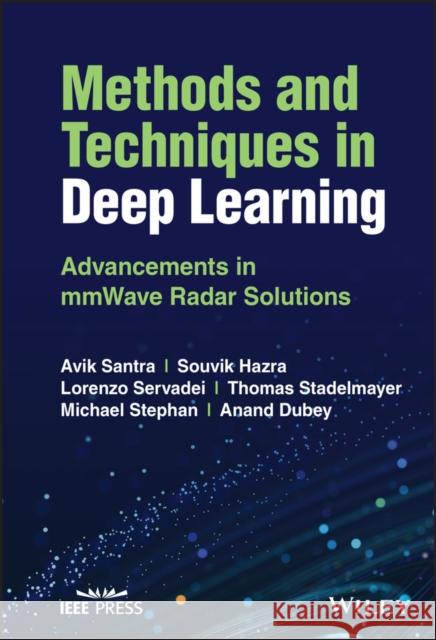Methods and Techniques in Deep Learning: Advancements in Mmwave Radar Solutions » książka



Methods and Techniques in Deep Learning: Advancements in Mmwave Radar Solutions
ISBN-13: 9781119910657 / Angielski / Twarda / 2022
Methods and Techniques in Deep Learning: Advancements in Mmwave Radar Solutions
ISBN-13: 9781119910657 / Angielski / Twarda / 2022
(netto: 575,70 VAT: 5%)
Najniższa cena z 30 dni: 603,29 zł
ok. 22 dni roboczych.
Darmowa dostawa!
PrefaceAcronyms1 Introduction to Radar Processing & Deep Learning 11.1 Basics of Radar Systems 11.1.1 Fundamentals 21.1.2 Signal Modulation 21.2 FMCW Signal Processing 61.2.1 Frequency-Domain Analysis 71.3 Target Detection & Clustering 141.4 Target Tracking 191.4.1 Track Management 211.4.2 Track Filtering 221.5 Target Representation 281.5.1 Image Representation 301.5.2 Point-Cloud Maps 341.6 Target Recognition 361.6.1 Feedforward Network 371.6.2 Convolutional Neural Networks (CNN) 371.6.3 Recurrent Neural Network (RNN) 431.6.4 Autoencoder & Variational Autoencoder 471.6.5 Generative Adversial Network 511.6.6 Transformer 541.7 Training a Neural Network 561.7.1 Forward Pass & Backpropagation 571.7.2 Optimizers 621.7.3 Loss Functions 651.8 Questions to the Reader 66Bibliography 682 Deep Metric Learning 752.1 Introduction 782.2 Pairwise methods 792.2.1 Contrastive Loss 792.2.2 Triplet Loss 802.2.3 Quadruplet Loss 812.2.4 N-Pair Loss 822.2.5 Big Picture 832.3 End-to-end Learning 842.3.1 Cosine Similarity 862.3.2 Euclidean Distance 952.3.3 Big Picture 1002.4 Proxy methods 1032.5 Advanced Methods 1032.5.1 Statistical Distance 1042.5.2 Structured Metric Learning 1082.6 Application Gesture Sensing 1102.6.1 Radar System Design 1112.6.2 Data Set and Preparation 1122.6.3 Architecture and Metric Learning Procedure 1142.6.4 Results 1232.7 Questions to the Reader 129Bibliography 1303 Deep Parametric Learning 1353.1 Introduction 1353.2 Radar Parametric Neural Network 1403.2.1 2D Sinc Filters 1423.2.2 2D Morlet Wavelets 1433.2.3 Adaptive 2D Sinc Filters 1453.2.4 Complex Frequency Extraction Layer 1463.3 Multilevel Wavelet Decomposition Network 1503.4 Application Activity Classification 1533.4.1 Proposed Parametric Networks 1553.4.2 State-of-art Networks 1583.4.3 Results & Discussion 1603.5 Conclusion 1673.6 Question to Readers 168Bibliography 1684 Deep Reinforcement Learning 1734.1 Useful Notation and Equations 1734.1.1 Markov Decision Process 1734.1.2 Solving the Markov Decision Process 1744.1.3 Bellman Equations 1754.2 Introduction 1754.3 On-Policy Reinforcement Learning 1794.4 Off-Policy Reinforcement Learning 1804.5 Model-Based Reinforcement Learning 1804.6 Model-Free Reinforcement Learning 1814.7 Value-Based Reinforcement Learning 1814.8 Policy-Based Reinforcement Learning 1834.9 Online Reinforcement Learning 1834.10 Offline Reinforcement Learning 1844.11 Reinforcement Learning withDiscrete Actions 1844.12 Reinforcement Learning withContinuous Actions 1854.13 Reinforcement Learning Algorithmsfor Radar Applications 1854.14 Application Tracker's Parameter Optimization 1894.14.1 Motivation 1904.14.2 Background 1924.14.3 Approach 2024.14.4 Experimental 2084.14.5 Outcomes of the proposed Approach 2194.15 Conclusion 2204.16 Questions to the Reader 220Bibliography 2215 Cross-Modal Learning 2295.1 Introduction 2295.2 Self-Supervised Multi-Modal Learning 2335.2.1 Generating Audio Statistics 2335.2.2 Predicting sounds from images 2345.2.3 Audio Features Clustering 2345.2.4 Binary Coding Model 2355.2.5 Training 2355.2.6 Results 2355.3 Joint Embeddings Learning 2375.3.1 Feature Representations 2375.3.2 Joint-Embedding Learning 2385.3.3 Matching & Ranking 2395.3.4 Training Details & Result 2395.3.5 Discussion 2415.4 Multi-Modal Input 2415.4.1 Multi-modal Compact Bilinear Pooling 2425.4.2 VQA Architecture 2435.4.3 Training Details & Result 2455.4.4 Discussion 2455.5 Cross-Modal Learning 2455.5.1 Data Acquisition 2465.5.2 Cross-Modal Learning for Key-Point Detection 2465.5.3 Training Details & Result 2475.5.4 Discussion 2495.6 Application People Counting 2505.6.1 FMCW Radar System Design 2515.6.2 Data Acquisition 2525.6.3 Solution 1 2535.6.4 Solution 2 2625.7 Conclusion 2655.8 Questions to the Reader 265Bibliography 2676 Signal Processing with Deep Learning 2736.1 Introduction 2736.2 Algorithm Unrolling 2746.2.1 Learning Fast Approximations of Sparse Coding 2756.2.2 Learned ISTA in radar processing 2796.3 Physics-inspired Deep Learning 2826.4 Processing-specific Network Architectures 2846.5 Deep Learning-aided Signal Processing 2886.6 Questions to the Reader 297Bibliography 2977 Domain Adaptation 3037.1 Introduction 3037.2 Transfer Learning and Domain Adaptaton 3047.3 Categories of Domain Adaptation 3077.3.1 Common Data Shifts 3077.3.2 Methods of Domain Adaptation 3087.4 Domain Adaptation in Radar Processing 3157.4.1 Domain Adaptation with a different Sensor Type 3167.4.2 Domain Adaptation with different Radar Settings 3187.5 Summary 3317.6 Questions to the Reader 331Bibliography 3328 Bayesian Deep Learning 3398.1 Learning Theory 3418.2 Bayesian Learning 3438.3 Bayesian Approximations 3528.4 Application VRU Classification 3728.4.1 VAE as Bayesian 373xiii8.4.2 Bayesian Metric Learning 3778.4.3 Kalman as Bayesian 3838.4.4 Results 3878.5 Summary 3918.6 Questions to the Reader 393Bibliography 3939 Geometric Deep Learning 3979.1 Representation Learning in Graph Neural Network 3999.1.1 Fundamentals 3999.1.2 Learning Theory 4019.1.3 Embedding Learning 4069.2 Graph Representation Learning 4079.2.1 Convolution GNN 4089.2.2 Recurrent Graph Neural Networks (RGNN) 4099.2.3 Graph Autoencoders (GAE) 4099.2.4 Spatial-Temporal Graph Neural Networks (STGNN) 4109.2.5 Attention GNN 4109.2.6 Message-passing GNN 4119.3 Applications 4139.3.1 Application 1 Long-Range Gesture Recognition 4139.3.2 Application 2 Bayesian Anchor-Free Target Detection 4269.4 Conclusion 4449.5 Questions to the Reader 445Bibliography 446
Avik Santra is Head of Advanced Artificial Intelligence at Infineon Technologies, Munich, Germany.Souvik Hazra is a Senior Staff Machine Learning Engineer at Infineon Technologies, Munich, Germany.Lorenzo Servadei is a Senior Staff Machine Learning Engineer at Infineon Technologies and a Lecturer at The Technical University of Munich (TU München), Germany.Thomas Stadelmayer is a Staff Machine Learning Engineer at Infineon Technologies, Munich, Germany.Michael Stephan is a PhD candidate at Infineon Technologies, Munich, Germany and Friedrich-Alexander-University of Erlangen-Nürnberg, Germany.Anand Dubey is a Staff Machine Learning Engineer at Infineon Technologies.
1997-2025 DolnySlask.com Agencja Internetowa
KrainaKsiazek.PL - Księgarnia Internetowa









